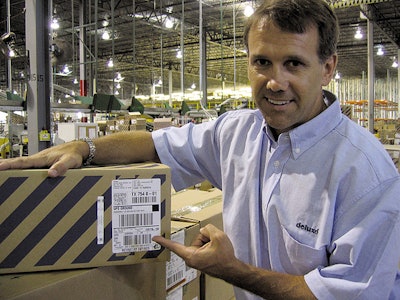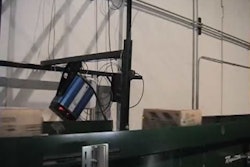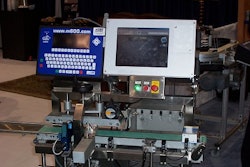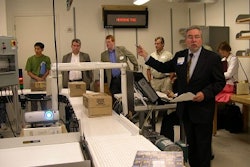A foundation to successful RFID implementation beyond “slap and ship” includes expandability for future growth. A keen eye toward RFID scalability was the vision of Deluxe Media Services, a third-party logistics (3PL) provider based in Vernon Hills, IL. The company’s RFID initiative permits its customers, such as Sony, Universal, and Paramount, to have their movie DVDs delivered to retailers in RFID-enabled cases. Deluxe’s solution, RFID in a box™ from Manhattan Associates, allows the 3PL to meet retailer mandates. Those include Wal-Mart’s as well as announced 2006 requirements by Target and Best Buy. Deluxe went live with RFID in April, according to Jeff Nelson, director of engineering at Deluxe.
“We chose Manhattan Associates’ Integration Platform for RFID because it provided the robust, user-friendly and scalable architecture we were looking for,” says Nelson. “We needed a solution that was flexible enough to integrate throughout our supply chain—from a high-volume, high-speed operation to our low-volume, less automated sites. We implemented the solution with minimal changes to our existing operations and at reasonable costs.”
Besides Manhattan, other companies that played a crucial role for Deluxe’s RFID implementation were Blue Horseshoe, which made system modifications to minimize disruptions to Deluxe’s processing flow, and Siemens, which provided Dematic Rapistan conveyors and components for a new 130-ft-long conveyor spur with the RFID station that was added.
Currently, Deluxe tags and ships only boxes of product destined for Wal-Mart’s RFID-enabled DCs in the Dallas, TX, area. That’s a volume that will increase in the coming months; by year’s end, Deluxe will begin shipping RFID-tagged boxes to Best Buy.
Two applications at three DCs
Deluxe is using RFID for boxes of new DVD releases at three of its distribution centers, including its most automated facility in Pleasant Prairie, WI, 50 miles north of Chicago. That site is a 535ꯠ-sq-ft DC that Packaging World visited in July.
Deluxe uses RFID for two applications:
1. Conveyable corrugated boxes containing from five to 100 DVDs that measure up to 16x24x23”. These receive a 4’’x1¼2’’ on-pitch or naked RFID tag that’s applied manually in the form it’s received from the vendor.
2. Larger display-unit boxes that are too bulky to convey. One unconveyable box can fill a pallet and contain as many as 2ꯠ DVDs, Nelson says. These receive a 4’’x6’’smart label, a fully printed label with the RFID tag embedded.
Both kinds of Gen 1 Class 1 EPC tag labels are applied manually, though Deluxe expects to upgrade to automatic label applicators early next year.
The larger boxes receive a smart label in a vertical format generated by a Zebra Technologies’ model R110Xi printer-encoder with RFID capability via ThingMagic technology. Deluxe selected Zebra primarily because the facility has standardized with Zebra printers, Nelson says. All printers are housed in a temperature climate-controlled room.
RFID for those boxes conforms to Deluxe’s current processes, Nelson says, making it essentially a seamless transition. Deluxe had been applying a label that looks similar, except now it is RFID encoded using a different printer to generate the labels, Nelson points out.
The smart labels are printed with a human-readable EPC Electronic Product Code Number (EPC). Although not required by Wal-Mart, that’s a Best Buy directive that Deluxe uses in anticipation of shipping RFID-tagged products to the electronics retailer starting later this year, according to Nelson. The labels are also printed with the EPC logo.
Conveyed boxes go to RFID station
The conveyable boxes, by far the larger volume at this DC, are handled using a combination of automatic diverting in conjunction with a manned RFID station. The naked tag is applied manually in the form it is received, in rollstock from Alien Technology.
After orders are picked for customer shipment, the boxes are placed onto a main elevated conveyor ahead of the outbound dock doors. Deluxe’s Bob Thompson, vice president of supply chain services, says the RFID system is designed to work at their conveyors’ typical speeds of 60 cases per minute.
All outbound boxes (RFID-designated or not) are conveyed past a bar-code scanner that reads the standard label’s UCC 128/SSCC (Serial Shipping Container Code) number and uploads that data to Deluxe’s Warehouse Management System software, Manhattan’s Logistics PRO, which Deluxe has used for a while. All boxes are then automatically diverted to the appropriate conveyor leading down to the appropriate dock door location. If a box is found to be designated for RFID application, it is automatically diverted to an RFID commissioning station at the end of the new 130-ft long conveyor spur.
Near the end of the spur, the box is delivered by powered roller conveyor to a position just ahead of the Alien reader-antenna portal. The operator manually applies the naked RFID tag, then uses a handheld Symbol Technologies bar-code scanner to read the SSCC bar code. SSCC identification is used to commission the RFID tag, which is done at a touchscreen computer-monitor via Manhattan’s Internet-based EPC Manager program.
Both types of Deluxe’s RFID tags, naked or smart, use 96-bit SSCC EPC formatting. SSCC is used for mixed packs containing more than one SKU, such as Deluxe’s cases containing mixed SKU DVDs, according to Manhattan’s senior director of RFID, Davison Shopmeyer. Shopmeyer claims Deluxe is one of the first companies to use this format. “The large majority of consumer packaged good companies ship full cases and pallets to Wal-Mart and use GTIN encoding,” he says.
The box is then pushed through the antenna portal where the naked tag is encoded with the case-specific EPC data by an Alien Technologies’s Model 9780 reader using Manhattan EPC Manager middleware. A light beacon confirms a good write and read. Deluxe says the entire commissioning process takes about 10 seconds.
The box is returned to the dock door area where it is scanned by a dock worker using a Psion Teklogix hand-held RFID reader and then directed to the proper outbound shipment.
RFID box volumes at Deluxe currently average about several hundred units per day as Deluxe awaits more stores and retailers going live with RFID. However, those volumes tend to be concentrated in orders of several hundred to 1ꯠ boxes per day.
Challenges and improvements
The read success rate at Deluxe is above 90%, but it hasn’t always been that high. And it should be higher someday, according to managers.
Deluxe’s initial smart label read rate was a dismal 50% until they uncovered the problem.
“Make sure your label converter is placing the RFID chip in the right place on the label stock to match the printer’s RFID encoder orientation,” advises Nelson. “We learned that the hard way, but at least it was discovered during the testing phase.”
Thompson wants to see read rates go even higher. “We can only replace bar codes if the read rates can get to 99%-plus. Even at 95%, if you ‘lose’ one out of 20 parcels because you can’t read it, that’s not going to work for automation.”
As converters continue to improve, Nelson expects those rates to rise. Deluxe also anticipates better read rates when Gen 2 tags become available.
Deluxe has found that the success rate for the naked tags are a little higher than for the smart labels. Deluxe pegs the costs for its smart labels, which are currently provided by Paxar Corp., at 20¢ to 25¢ apiece.
What’s ahead?
“To better understand what other retailer requirements are,” responds Nelson.
Although its current solution is at case level, Deluxe is expecting to add pallet-level RFID for Best Buy. And, when volumes warrant, Deluxe will add an automatic tag-label applicator at the RFID station.
“Our primary focus was to meet the retailer mandate for our customers,” Nelson explains. “The next step is to see what internal benefits we can gain from this.”
However, Thompson isn’t optimistic about finding internal benefits any time soon, believing Deluxe will have to dig for a while to find them.
“Companies that have the most to gain from RFID implementation are those in nonautomated operations moving into a mandate requirement,” opines Thompson. “They can design a system to not only do what we do using bar codes, but perhaps enhance their processes using RFID while satisfying a mandate at the same time. If they have highly automated operations, they are already going to be hard-pressed to see internal value in RFID, other than the possibility of increased sales.”
That will be a different story when it comes to item-level RFID on individual DVDs, which Deluxe feels is a few years away.
“Everyone’s doing research on that,” says Thompson, “and we hope we’re involved, too, though I believe it will be a different world—not only will item-level tags be different [than case level], the manufacturing process will have to be changed to be able to embed the tag into the product.”
Periodic case-level RFID tagging is only a preview of things to come for this purveyor of DVDs.
See sidebar to this article: Deluxe testing and training
For a complete list of suppliers mentioned in this story, see: packworld.com/go/w154



























